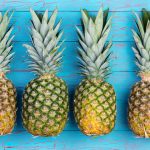
Pineapples [Ozgur Coskun:Getty Images]
Kenya is among the major tropical countries that supply the world with their pineapples. It competes with Asia Pacific countries like the Philippines, the Indian subcontinent, Central America and south-east Asia in the growth of the fruit. In all, the eighty-two nations that grow pineapples cover over two million acres of the fruit.
The pineapple is only second to the banana as the world’s most exported produce. This owes partly to its hundreds of cultivars, numbering at least 600. The main variety in Kenya is Smooth Cayenne which represents 8 out of every 10 pineapples produced in the country.
In Kenya, the pineapple is synonymous with large-scale production particularly under modernized agriculture in the Central region. The majority of family growers are concentrated in the Western and Coastal areas where the soil is richly sandy. The farmers propagate the Smooth Cayenne and Sweet cultivars but MD2 has become a new big contender.
A Historical Background of Big Time Farming
The first pineapple grew in Kenya along the Coast courtesy of Portuguese explorers who introduced it. The explorers could have obtained it from its native home in South America before delivering it to East Africa en-route to India. Indeed, Malindi at the coast is still second to Thika in production while Kisii in Western Kenya ranks third.
The colonial administration in Kenya was keen to cash in on a fruit that retailed at the then golden value of $15 a ton in the late 1940s. They curated various locales in the country including Nairobi following the thriving of coffee in the same area but the crop failed. It was then that they expanded to Thika and the trial bore fruit due to the conducive friable sandy soil of the region. This meant that growers could manage to meet the burgeoning demand of the settlers all over the White Highlands and new urban centers.
The establishment of a canning plant in the pre-independence days saw Kenya’s pineapple sector increasingly rely on smallholder suppliers from Kiambu. By independence, it was clear that demand had outstripped supply and the existing contractor growers could not satiate the demand. It was then that the country sought out large-scale growers from abroad, in search of greener pastures with low-paid labor force. Del monte from the United States fell for the invitation by the now postcolonial authorities. The firm began as Kenya Canners before changing the name after a 98 percent change in shareholding at the turn of the millennium.
The company was the initial and still is the leading large-scale grower of the fruit in the country. Its early operations entailed sourcing fruits from the surrounding farmers under contractual terms. Though it does not accept input from family growers nowadays, it has created a market potential for them by protecting the quality of exports. Apparently, the reason it does not use the services of other sources is to up the quality, a major point of concern in the international market. Its current plantation in Thika dates back to 1965 when the then post-independence government leased land under sisal to the company to spearhead an ambitious pineapple project.
Kakuzi, on the other hand, has its extensive plantation tens of kilometers just off the land owned by Del Monte. Currently, the two firms co-export their produce. They have also partnered on a farm of over a thousand hectares under the fruit, but Kakuzi has a sixty-four-hectare land that targets Kenya’s consumers.
The Selling Price Changes Little
Unlike other fruits that fluctuate sharply in price, Kenya pineapples have retained a stable price over the years. A fruit of a small size goes for $0.5 while a big one receives double the price. In times of economic upset, one can buy the smallest fruit for $0.3 at the urban market while at the farm gate it goes for $0.4.
Pineapple Uses Have Just Expanded a Notch
The use of the pineapple in Kenya does not end at eating it raw. The sumptuous juice makes processed products that range from jam to preserves. The latest technologies in the fruit processing industry have also increased the utility of the ripe fruit. Pineapple wine is such a product that comes from the distillation of the pulp juice. There is also pineapple vinegar with a nutritious pure content. Preserves, on the other hand, are products of crystallization of the fruit which then undergoes glacing.

Culinary uses of pineapples [RojoImages/Getty Images]
Outside the people’s realm, pineapple by-products have also served as cattle feed. During the production of juice and other canned products, the lees of the fruit forms nutritious cattle fodder that is also sold commercially. Even the leaves in some countries in the Far-East produce fibers that make clothes in a similar fashion as sisal vines.
The Nutrition Remains that of a Superfood
Eating pineapples gives the body healthy nutrition. As the following list of nutrients indicates, energy and immunity vitamin are the two healthy highlights from the fruit:
•Energy daily value (dv): 50 calories.
•Starch dv: 4 percent.
•Potassium dv: 3 percent.
•Vitamin C dv: 80 percent.
•Vitamin 6 dv: 6 percent.
•Protein, calcium and phosphorous dv: 1 percent each.
A Brief Growing Guide
Pineapples in Kenya grow under relatively warm conditions of 20° Celsius but can sustain extreme heat of up to 45° Celsius. They may lose their chlorophyll pigment if they grow under temperatures below that minimum due to lack of the sun. They are very sensitive to cold but they can sustain for a temporary duration in cool weather. It is also true that prolonged exposure to temperatures above 45°C can be detrimental to the dome of the fruit due to solar radiation when it is not covered by the vines.
With the above cautions in mind, here are the main growth conditions of Kenya pineapple:
•Though the fruits thrive from sea level to 2000 meters elevation, the best elevations are up to 1800m to prevent the fruit turning sour.
•They are some of the cash crops with least irrigation needs of just 1100 millimeters of rain yearly.
•Unlike the popular notion that sandy soil is the best, pineapples require a mixture of sandy and loamy soils with looseness of about 60 centimeters deep.
•It is also important to have soils that are well-drained which exempts black and red soils since they clog with water and turn sticky.
•During the 22 months it takes the fruit to mature, it requires frequent farmyard compost with a balanced nitrogen content. Ideally, 25,000 kilos of manure prior to planting and an equal amount after planting are essential per hectare.
•In terms of planting material, three candidates including slips, crowns and suckers are in use Slips are the leaves that shoot from the fruit’s stalk and take relatively short to bear fruits at 22 months. Crowns constitute the cluster of leaves atop every fruit and are the easiest to use but take longest to mature at 25 months. Suckers constitute the root section of the fruit and are the hardest to grow of the three but shortest to mature at 18 months.
•The slips, suckers and crowns can replicate and are therefore possible to slice halfway in vertical formation to make more planting materials. The best planting method is in rows of forty centimeters apart and twenty centimeters between one plant and the next.
•The harvesting of pineapples takes place at least 18 months after planting and thereafter each nine months. The indicator of harvest-ready fruits for export is when they partially come off the enshrouding vines at the base or acquire greenish-yellow tint at the bottom of the fruit. For Kenya pineapples bound for resell, the date of harvesting is postponed until the fruit is near ripe. The picking process involves lateral slicing by a sharp knife without injuring either the fruit or the stalk from which slips for planting sprout.
The Grading Remains the Same
There are two types of grading that have traditionally attributed to Kenya pineapples. The main method is that of the selection of the fruits by size. This is best for dry fruits meant for selling in the export markets. Grade 1 is widest at 12.7 centimeters. The second grade is medium across at 10.8 centimeters while the third grade measures 8.9 centimeters across.
The other grading method is that of measuring the relative brix degree. This indicates the proportion of sugar versus acidic content. Pineapples grown under mid altitudes such as Thika have low acidity or sourness and thus fall under the ideal 13-15 brix degrees. They are suitable for juice, concentrate and other canned products.
The Rise of Export Markets
To pinpoint the popular demand of the fruit, even countries that grow it under special conditions like Israel still go on to import it at extreme prices. While you can buy the fruit for just $0.6 in Kenya, it goes to $9.55 in an Israeli grocery store, which is 15 times more.
Other places with high import potential include European countries which account for about 0.9 million tons of shipments per year. The main imports are raw fruits and canned products. The most preferred variety is MD2 while the biggest suppliers in the world include companies from Kenya. The European Union recommends sizes A to H, with the former being 2750g and the latter 800g per fruit in terms of weight. The bloc does not accept the tiniest varieties, which local growers instead sell directly to the consumers. For the prospective exporter, most shipping boxes weigh 12 kilograms and contain between five and ten fruits apiece. These ought to be in no contact with other produce, particularly bananas. The latter may cause fast ripening in transit due to their ethylene production which taints any surrounding produce.
Kenya pineapples compete with their Guatemalan, Mexican and Chinese counterparts and perform well partly due to long-term export tradition and quality monitoring by the major exporters. Other world sources include Indonesia, India and the Philippines.
The most expensive places to source pineapples from Kenya is Busia, despite being a growing belt. A 2017 price index for the country showed that the fruit retailed at KSH1300 ($13) per thirteen kilos in the urban center. The same fetched KS1170 ($11.7) in Nairobi and KSH 900 ($9) in the coastal city of Mombasa.
In short, the glory days of the Kenya pineapple remain although smallholder farmers have been eclipsed by large plantations. In a context where 1100 hectares are partitioned between two major growers, it follows that small growers are the minority unlike other farming activities where they dominate. As compensation, small growers have turned into traders of the fruits they obtain from the plantations for sale on the road sides and urban markets.
References
http://www.infonet-biovision.org/PlantHealth/Crops/Pineapple
http://www.kakuzi.co.ke/products/pineapple
http://sokodirectory.com/2017/04/lucrative-business-pineapple-farming-kenya/
http://www.farmerstrend.co.ke/why-del-monte-grows-pineapple-in-thika-and-why-it-doesnt-take-any-grown-by-smallholders/
https://www.sde.co.ke/thenairobian/article/2000202320/parklands-was-to-be-a-pineapple-plantation
https://www.cbi.eu/market-information/fresh-fruit-vegetables/pineapple/
http://farmbizafrica.com/markets/527-pineapple-export-market-is-wide-for-kenya

